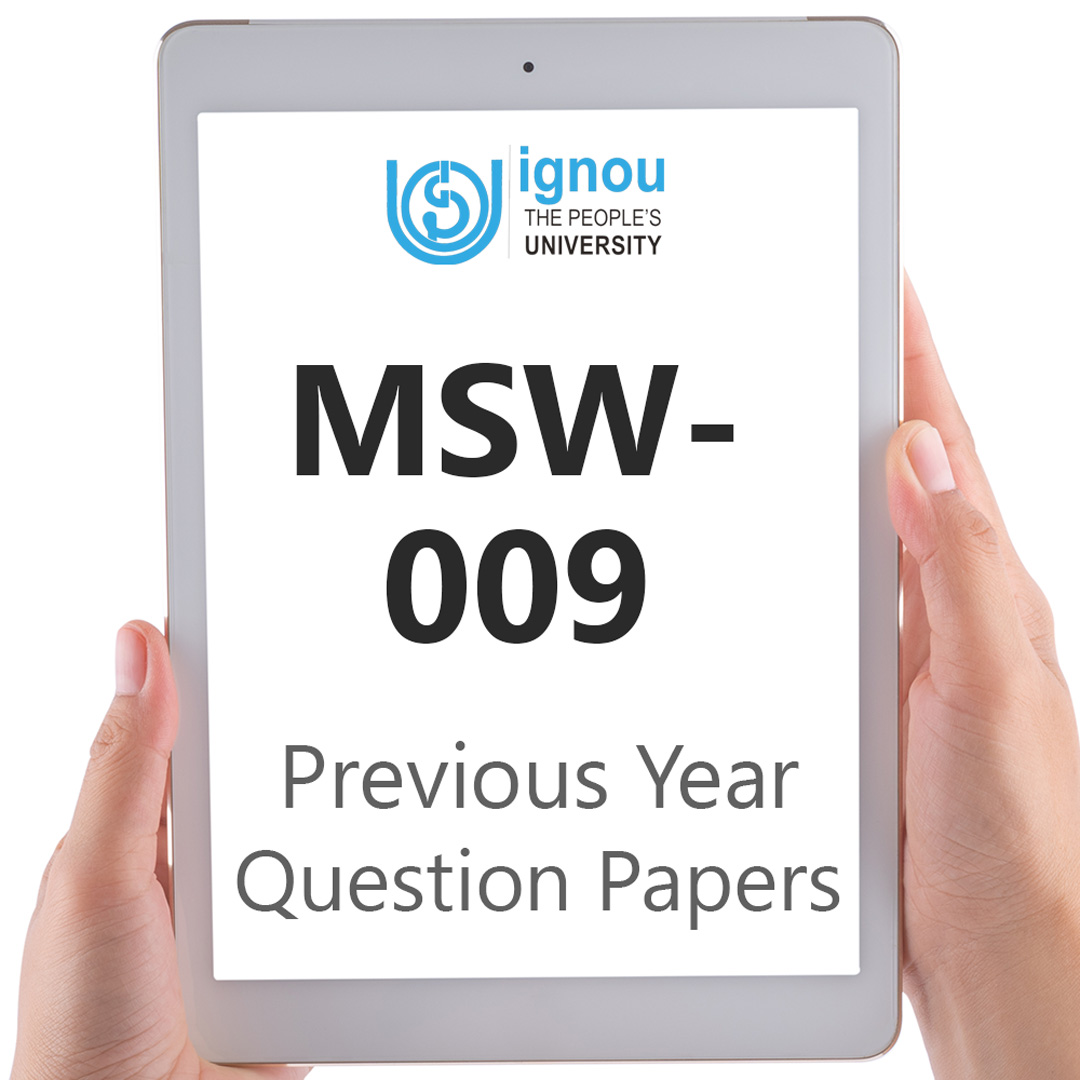If you are looking for MSW-009 IGNOU Solved Assignment solution for the subject Community Organisation Management for Community Development, you have come to the right place. MSW-009 solution on this page applies to 2023-24 session students studying in MSW, MSWC, MACSR, PGDCSR courses of IGNOU.
MSW-009 Solved Assignment Solution by Gyaniversity
Assignment Code: MSW-009/TMA/2023-24
Course Code: MSW-009
Assignment Name: Community Organization Management for Community Development
Year: 2023-2024
Verification Status: Verified by Professor
Note: (i) Answer all the five questions.
(ii) All questions carry equal marks.
(iii) Answers to question no. 1 and 2 should not exceed 600 words each.
Q1) Delineate history of social welfare administration in India.
Ans) The history of social welfare administration in India spans various periods, evolving in response to social, economic, and political changes:
Pre-Independence Era:
Ancient Systems: India had a tradition of community-based welfare known as "Dharma" that emphasized caring for the disadvantaged. Kings and religious institutions provided aid.
Colonial Rule: British colonial policies focused on maintaining social order. Early efforts in relief and social reforms were primarily charity-based and focused on specific issues like poverty alleviation and education.
Post-Independence (1947 - 1970s):
Development Planning: India's independence led to the adoption of five-year plans focusing on economic development and poverty eradication. The state took responsibility for welfare programs.
Community Development: Initiatives like the Community Development Program (CDP) aimed at rural development, emphasizing community participation and self-help.
1970s - 1990s:
Expansion of Welfare Programs: This period saw the expansion of social welfare schemes, including poverty alleviation programs, health initiatives, and education reforms.
Introduction of Social Security: The government initiated social security measures like pensions and insurance for specific groups.
1990s Onward:
Liberalization and Privatization: Economic reforms in the 1990s emphasized liberalization, reducing the government's direct role in welfare provision, and encouraging private participation.
Shift towards Targeted Programs: Social welfare programs became more targeted, focusing on marginalized groups like women, children, and rural populations.
Recent Trends:
Digital Initiatives: The government introduced digital platforms for welfare delivery, enhancing transparency and efficiency in welfare schemes.
Focus on Inclusive Growth: Recent policies emphasize inclusive growth, promoting social welfare through initiatives like the National Rural Employment Guarantee Act (NREGA) and schemes for healthcare, education, and poverty alleviation.
India's social welfare administration has evolved from charity-based efforts to comprehensive welfare programs aimed at social justice, poverty reduction, and inclusive development. Current efforts focus on improving access, targeting vulnerable groups, and leveraging technology for efficient delivery of social services.
Q2) Highlight the trajectory of development of community organization in United Kingdom and United States of America.
Ans) The trajectory of community organization in the United Kingdom (UK) and the United States of America (USA) reflects distinct historical and social contexts:
United Kingdom (UK)
Early 19th Century: The UK witnessed the emergence of philanthropic efforts and charity organizations aimed at addressing social issues caused by industrialization and urbanization.
Late 19th Century: Settlement house movements like Toynbee Hall in London provided community services, education, and cultural exchange to improve living conditions in urban areas.
Early to Mid-20th Century: Social work and community organization gained recognition, particularly during World War I and World War II, where efforts were directed toward social welfare and rehabilitation of war-affected communities.
Post-War Era: The Beveridge Report in 1942 laid the foundation for the modern welfare state in the UK, leading to the establishment of social welfare policies and the National Health Service (NHS).
United States of America (USA)
Late 19th Century: Settlement house movements like Hull House by Jane Addams in Chicago focused on community-based services, education, and social reform for immigrants and the urban poor.
Early to Mid-20th Century: The Great Depression prompted the New Deal policies, introducing social security programs and community-based initiatives to alleviate poverty.
Civil Rights Era: Community organization played a pivotal role during the Civil Rights Movement, advocating for racial equality, desegregation, and social justice.
Late 20th Century Onward: Emphasis on community development programs, grassroots movements, and social advocacy for various causes, including environmental issues, healthcare access, and LGBTQ+ rights.
Both the UK and the USA have seen the evolution of community organization from early philanthropic efforts to more structured social welfare policies and grassroots movements. The approaches have been shaped by historical events, social movements, and shifts in government policies, emphasizing community engagement, empowerment, and social justice.
Q3) Answer any two of the following questions in about 300 words each:
Q3. a) Enumerate eight purposes as given by Weil & Gamble that provide basis of community practice engagement.
Ans) Weil and Gamble outlined eight purposes that serve as the foundation for engagement in community practice. These purposes guide social workers and practitioners in their efforts to facilitate community development, empowerment, and social change:
Promoting Social Justice:
Advocating for fairness, equity, and equality within communities. It involves addressing systemic injustices, discrimination, and inequalities to ensure everyone has access to resources and opportunities.
Building Community Capacity:
Strengthening the skills, resources, and abilities within a community. This involves empowering individuals and groups to identify and address their own needs and challenges effectively.
Empowering Marginalized Populations:
Focusing on the needs of marginalized or oppressed groups within communities, empowering them to advocate for their rights, access services, and participate in decision-making processes.
Facilitating Social Change:
Engaging in efforts that lead to transformative and sustainable changes in social structures, policies, and systems. This purpose aims to address root causes of social problems and foster long-term positive change.
Building and Sustaining Relationships:
Fostering connections and partnerships within and outside the community to create supportive networks. Building relationships enhances collaboration and collective action towards common goals.
Enhancing Democratic Participation:
Encouraging active involvement and participation of community members in decision-making processes. This purpose aims to ensure inclusivity, representation, and diverse voices in shaping community initiatives.
Promoting Critical Reflection and Learning:
Encouraging critical thinking, dialogue, and continuous learning within communities. Reflective practices enable individuals and groups to analyse social issues, develop new perspectives, and adapt strategies.
Promoting Ethical and Competent Practice:
Adhering to ethical standards and maintaining professional competence in community practice. Upholding ethical principles ensures accountability, respect, and integrity in all engagements.
Q3. b) Discuss frameworks to look at the community from the social work practitioner's perspective.
Ans) Social work practitioners utilize various frameworks to understand and engage with communities, aiming to address social issues and promote positive change. Some key frameworks include:
Ecological Perspective:
This framework views communities within their broader ecological context, emphasizing the interconnection between individuals, families, communities, and larger societal systems. It considers the impact of multiple systems (micro, meso, exo, macro, and chrono) on community functioning, highlighting the importance of assessing environmental influences, resources, and social networks.
Strengths-Based Approach:
Focusing on community assets, strengths, and capabilities rather than deficits, this framework emphasizes leveraging existing resources within communities. It aims to empower individuals and communities by identifying and utilizing their strengths to address challenges and promote positive change.
Asset-Based Community Development (ABCD):
ABCD emphasizes identifying and mobilizing a community's internal assets, including its skills, talents, and resources. It involves engaging community members in identifying their strengths and using them to address needs and create solutions, fostering community ownership and resilience.
Community Empowerment Framework:
This framework aims to empower communities by promoting participatory decision-making, collective action, and social justice. It emphasizes building community capacity, encouraging self-determination, and fostering leadership among community members to address systemic barriers and inequalities.
Cultural Competence and Diversity Framework:
Recognizing the diversity within communities, this framework emphasizes understanding and respecting different cultural perspectives, values, and identities. It guides practitioners to engage sensitively with diverse communities, acknowledging cultural strengths and addressing cultural barriers in service delivery.
Social Justice and Human Rights Perspective:
Focused on social change and advocacy, this framework emphasizes challenging systemic injustices and advocating for policies that promote equity and human rights within communities. It calls for addressing structural inequalities and promoting inclusive practices.
Q4) Write short notes on any four of the following in about 150 words each:
Q4. a) Give illustrations to the Abraham Maslow's Need Priority Model.
Ans) Abraham Maslow's Need Hierarchy Model illustrates human needs in a hierarchical order, ranging from basic physiological needs to higher-level psychological and self-fulfilment needs. Here are illustrations of the different levels:
Physiological Needs: homeless person seeks food, water, and shelter to survive.
Example: A food bank providing meals to the hungry or a shelter offering accommodation to the homeless.
Safety Needs: A person in a war-torn region seeks safety and security from conflict.
Example: Relief organizations providing shelter, safety, and aid to refugees or displaced individuals.
Belongingness and Love Needs: individual seeks social connections and relationships for support and companionship. Example: Support groups, social clubs, or community gatherings fostering a sense of belonging and camaraderie.
Esteem Needs: person seeks recognition, respect, and achievement in their professional or personal life.
Example: Workplace recognition programs, awards, or promotions acknowledging accomplishments.
Self-Actualization Needs: A person seeks personal growth, creativity, and fulfilment of their potential.
Example: Pursuing hobbies, creative endeavours, or engaging in activities that align with personal values and aspirations.
Q4. b) Discuss various types of social welfare administration in India.
Ans) In India, social welfare administration manifests through various types of programs and initiatives aimed at addressing diverse social concerns:
Poverty Alleviation Programs:
Initiatives like the Mahatma Gandhi National Rural Employment Guarantee Act (MGNREGA), National Social Assistance Program (NSAP), and Pradhan Mantri Garib Kalyan Yojana (PMGKY) focus on providing employment, financial aid, and social security to vulnerable populations.
Healthcare and Nutrition Programs:
Schemes such as Ayushman Bharat, National Health Mission (NHM), and Integrated Child Development Services (ICDS) aim to improve healthcare access, maternal and child health, and nutrition for marginalized communities.
Education and Skill Development Initiatives:
Programs like Sarva Shiksha Abhiyan (SSA), Rashtriya Madhyamik Shiksha Abhiyan (RMSA), and Skill India Mission focus on enhancing educational opportunities, skill development, and literacy rates.
Rural Development and Housing Programs:
Initiatives like Pradhan Mantri Awas Yojana (PMAY), National Rural Livelihoods Mission (NRLM), and Deen Dayal Upadhyaya Grameen Kaushalya Yojana (DDU-GKY) aim at rural development, housing, and creating livelihood opportunities.
Q4. c) Discuss characteristics features of a slum community in India.
Ans) Slum communities in India typically exhibit several characteristic features:
Overcrowding: Limited living spaces with high population density, often leading to cramped conditions and inadequate housing.
Poor Infrastructure: Lack of basic amenities like clean water, sanitation, electricity, and proper waste management facilities.
Informal Settlements: Often unauthorized or informal settlements on public or private land without legal recognition or basic services.
Economic Challenges: Low-income households engaged in informal or irregular employment, facing financial instability and limited access to formal financial services.
Social Vulnerability: Marginalized populations facing social stigma, exclusion, and limited access to education, healthcare, and social services.
Health Risks: Poor sanitation and inadequate healthcare facilities leading to higher susceptibility to diseases and health issues.
Limited Access to Resources: Limited access to education, employment opportunities, and social support services, perpetuating cycles of poverty.
Resilience and Community Bonds: Despite challenges, slum communities often exhibit strong social cohesion, collective support systems, and resilience in facing adversities.
Q4. d) Explain inherent values associated with community organization.
Ans) Community organization inherently embodies several values that guide its practice and engagement with communities:
Empowerment: Empowerment is a core value, emphasizing the importance of supporting communities to identify their strengths, resources, and capacities. It encourages active participation, decision-making, and autonomy among community members, fostering a sense of ownership and self-determination.
Social Justice: Community organization values social justice by aiming to address systemic inequalities, discrimination, and injustices within communities. It advocates for fairness, equality, and the protection of human rights, challenging oppressive structures and promoting equitable opportunities for all.
Collective Action: It values collective efforts and collaboration among community members, encouraging solidarity and collective problem-solving. By harnessing the collective power of the community, it seeks to address common concerns and achieve shared goals.
Inclusivity and Diversity: This value underscores the importance of respecting and valuing diverse perspectives, cultures, and identities within the community. It promotes inclusivity, recognizes diversity as a strength, and ensures representation and participation of all community members.
Q5) Write short notes on any five of the following in about 100 words each:
Q5. a) Rural Urban Dichotomy
Ans) The rural-urban dichotomy refers to the contrast or division between rural and urban areas based on distinct characteristics. Rural areas typically embody agricultural economies, smaller populations, and closer-knit communities. They often lack the infrastructure and services commonly found in urban settings. Conversely, urban areas are characterized by higher population density, diverse economies, better access to services, and infrastructure development. This dichotomy highlights differences in lifestyle, opportunities, access to resources, and socio-economic disparities between rural and urban communities, impacting aspects like employment, education, healthcare, and overall quality of life. Addressing the rural-urban divide often involves policies and interventions aiming to bridge disparities and ensure equitable access to resources and opportunities for both settings.
Q5. b) Kinship
Ans) Kinship is a term that describes the social links, interactions, and networks that exist within a civilization or community and are constructed on the basis of blood relations, marriage, or adoption. Family structures, ancestry, and societal duties are all defined by the intricate web of connections and obligations that are encompassed throughout this concept. Systems of kinship are different in different parts of the world, which can have an effect on patterns of interaction, inheritance, marriage practises, and social organisation. These relationships frequently hold cultural significance, as they determine duties, obligations, and interactions among family members, as well as shape societal standards and have an effect on individual identities within the context of the family and society.
Q5. c) SWOC (Strength, Weakness, Opportunity, and Challenges) Analysis
Ans) SWOC (Strengths, Weaknesses, Opportunities, and Challenges) analysis is a strategic tool used to assess an entity's internal and external factors:
Strengths: Identify internal positive attributes, resources, or capabilities within an organization or situation, such as skilled personnel, financial stability, or effective processes.
Weaknesses: Highlight internal limitations, vulnerabilities, or areas needing improvement, like lack of resources, outdated technology, or organizational inefficiencies.
Opportunities: Identify external factors or potential avenues for growth, improvement, or positive change, such as emerging markets, technological advancements, or new partnerships.
Challenges: Recognize external factors or obstacles that hinder progress or pose threats, such as competition, regulatory changes, economic downturns, or resource constraints.
Q5. d) POSDCoRB
Ans) POSDCoRB is an acronym representing the seven functions of management: Planning, Organizing, Staffing, Directing, Coordinating, Reporting, and Budgeting. It outlines essential managerial functions used in organizational settings:
Planning: Involves setting goals, defining strategies, and outlining actions to achieve objectives.
Organizing: Focuses on arranging resources, tasks, and structures to accomplish planned goals effectively.
Staffing: Involves recruiting, selecting, training, and developing personnel for various roles within the organization.
Directing: Encompasses guiding and motivating employees to achieve organizational objectives.
Coordinating: Involves harmonizing activities and resources to ensure they work together efficiently.
Reporting: Involves communicating information internally and externally about organizational performance.
Budgeting: Involves allocating financial resources and planning expenditures in line with organizational goals.
Q5. e) Lane Committee Report (1939)
Ans) The Lane Committee Report, also known as the Report of the Consultative Committee on Medical and Allied Services, was published in 1939 in the United Kingdom. Chaired by Lord William Henry Beveridge, the report laid the groundwork for the post-World War II welfare state. It recommended the establishment of a comprehensive national health service, proposing universal healthcare coverage, free at the point of service. The report highlighted the need for a coordinated approach to healthcare, advocating for state responsibility for the provision of medical and allied services. The principles outlined in the report were instrumental in shaping the subsequent development of the National Health Service (NHS) in the UK after the war.





